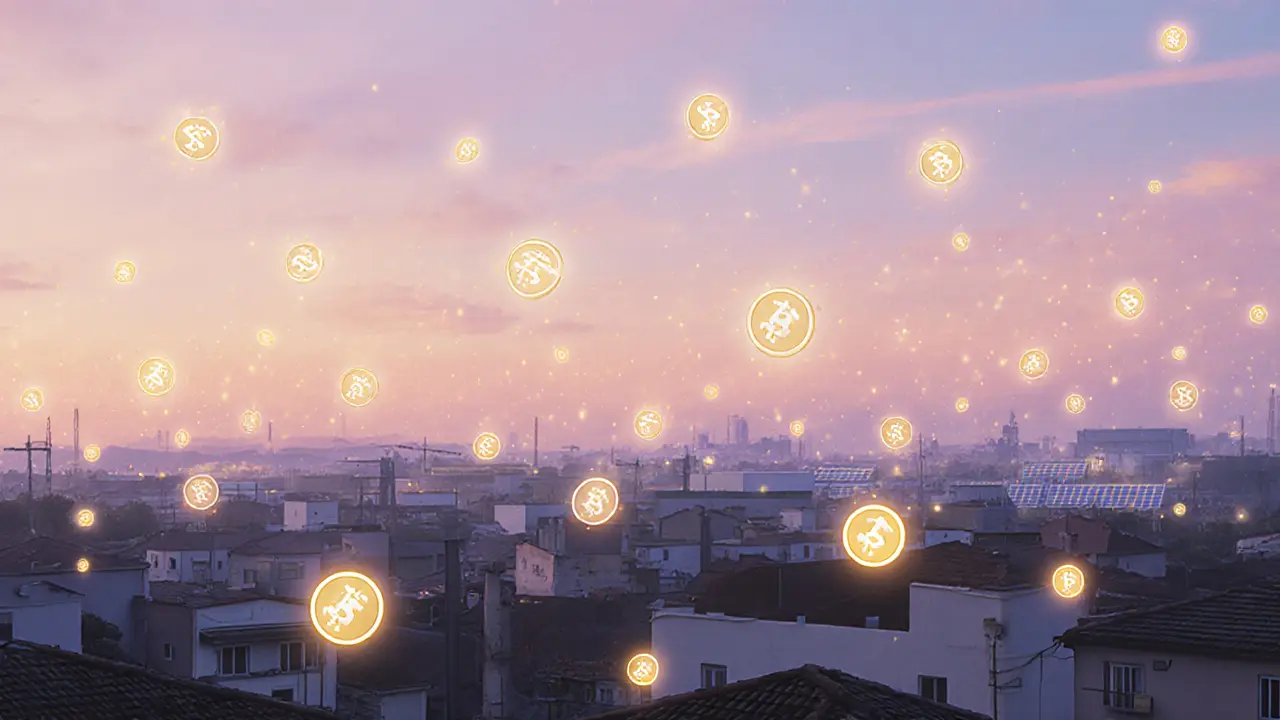Back in March 2022, FutureCoin (FUTURE) ran one of the more unusual airdrops on CoinMarketCap - not because it offered huge sums, but because it promised something most crypto projects never deliver: real-world value behind the token. The campaign gave away 200,000 FUTURE tokens to 1,000 lucky winners, with each winner getting up to 200 tokens. That’s not a fortune by today’s standards, but the structure was clever. It wasn’t just a free-for-all. You had to earn your ticket.
How the FutureCoin Airdrop Actually Worked
The system was simple: complete tasks, earn tickets, get entered into a lottery. One task gave you one ticket: retweeting a specific post from the @efuturecoin Twitter account. That was the base entry. But here’s where it got interesting - if you already held FUTURE tokens, you got bonus tickets. Hold 100 or more? One extra ticket. Hold 1,000 or more? Two extra tickets. And here’s the catch: you had to keep those tokens in your DeFi wallet until winners were announced. If you sold them before, you lost your bonus. That wasn’t just a rule - it was a way to reward loyal holders and stop people from jumping in just for the free tokens.That’s a smart move. Most airdrops attract people who take the free tokens and immediately dump them. FutureCoin wanted people who believed in the project. And they made sure only those who stuck around had a real shot at winning.
What Was FutureCoin Trying to Build?
FutureCoin didn’t position itself like most altcoins. It didn’t say, “We’re the next Bitcoin.” Instead, it claimed to be the first crypto backed by real, ongoing business projects. The idea was simple: every FUTURE token you held gave you a share of profits from real-world ventures - think solar farms in Australia, logistics tech in Southeast Asia, or small-scale manufacturing in Eastern Europe. The project said it had already launched over 12 pilot projects with combined valuations exceeding $4 billion. And unlike typical crypto projects that vanish after a hype cycle, FutureCoin claimed it was generating actual cash flow - and sharing it with token holders.This wasn’t just theory. The team said they had partnerships with established companies in logistics, renewable energy, and digital infrastructure. They weren’t just talking about blockchain - they were building physical assets that produced income. That’s why they called it a “constant utility” coin. It wasn’t meant to be traded like a meme coin. It was meant to be held, like a dividend stock - but on the blockchain.
Why CoinMarketCap Was the Right Place for This Airdrop
CoinMarketCap wasn’t just a random platform. In 2022, it was still the most visited crypto data site in the world. Millions of people checked prices, tracked wallets, and browsed new projects there every day. Running an airdrop on CoinMarketCap meant reaching people who were already serious about crypto - not just social media scammers or Telegram group lurkers. The platform had built-in trust. If a project was listed there, it had passed basic checks. That made the FutureCoin airdrop feel more legitimate than most.Plus, CoinMarketCap handled the logistics. You didn’t need to sign up for a separate site. You just logged into your existing CoinMarketCap account, clicked the airdrop tab, and followed the steps. No KYC, no wallet linking beyond what was needed for verification. It was clean, fast, and low-friction. That’s why it got over 50,000 entries - even though the prize pool was small.

How It Compared to Other Airdrops in 2022
Back then, airdrops were exploding. Projects like Meteora and Hyperliquid were giving away thousands of dollars in tokens just for using their testnets. Solana was handing out millions to early users. But most of those were speculative - you got tokens for doing nothing, then sold them the next day. FutureCoin was different. It asked you to prove you cared. Retweeting was easy, but holding tokens? That required belief.Compare it to Binance Launchpad airdrops - those required you to lock up BNB for weeks. FutureCoin’s version was gentler. You didn’t have to risk your own money. You just had to already own some FUTURE tokens to get the bonus. It was a low-barrier entry with a high-reward incentive for loyalty. That’s rare in crypto.
What Happened After the Airdrop?
The winners were announced in April 2022. Tokens were distributed directly to their wallets. Some winners cashed out quickly. Others held on. By mid-2023, FUTURE’s price had dropped over 70% from its peak - not because the project failed, but because crypto markets crashed. But here’s the twist: the real-world projects FutureCoin claimed to back were still running. Solar installations in Western Australia were generating electricity. A logistics app in Indonesia was processing 50,000 shipments a month. The token wasn’t moving, but the underlying assets were.By 2025, FUTURE tokens are still listed on a few smaller exchanges, but trading volume is low. The team hasn’t disappeared. They’ve shifted focus to scaling their real-world projects. They stopped marketing the token as an investment and started presenting it as a utility access key - like a membership to their network of income-generating ventures.

Could a Similar Airdrop Happen Again?
Maybe. But the crypto world has changed. In 2025, airdrops are mostly tied to Layer 2 chains like Arbitrum, zkSync, or Sui. Projects reward early testnet users, not social media followers. CoinMarketCap still runs airdrops, but they’re mostly for newer, high-profile projects with big VC backing. FutureCoin’s model - rewarding token holders who stick around - is rare now. Most new airdrops are designed for mass acquisition, not long-term loyalty.Still, FutureCoin’s approach was ahead of its time. It tried to build value from the bottom up - real projects, real income, real holders. That’s something most crypto projects still don’t get. If a similar campaign launched today, it might actually work better. People are tired of hype. They want substance.
What You Can Learn From This Airdrop
If you’re looking at future airdrops, here’s what matters:- Don’t chase free tokens. Look at what the project actually does. Does it have real products? Real users? Real revenue?
- Hold if you believe. Projects that reward long-term holders are signaling they care about sustainability, not just hype.
- Use trusted platforms. CoinMarketCap, CoinGecko, or official exchange portals are safer than random websites asking for your private key.
- Check the timeline. If a project launched in 2022 and hasn’t updated since, be skeptical. Crypto moves fast. Silence usually means trouble.
The FutureCoin airdrop didn’t make anyone rich overnight. But for those who held, it might have been the first step into a different kind of crypto - one built on real value, not just speculation.
Was the FutureCoin airdrop legitimate?
Yes, the FutureCoin airdrop on CoinMarketCap was legitimate. It was officially hosted on CoinMarketCap’s airdrop platform, required no private key sharing, and winners received tokens directly to their wallets. The campaign followed standard industry practices: social media tasks, bonus tickets for token holders, and transparent winner selection. However, while the airdrop itself was real, the long-term value of the FUTURE token has been volatile, and the project’s real-world claims have not been independently audited.
How many FUTURE tokens were distributed in the airdrop?
A total of 200,000 FUTURE tokens were distributed across 1,000 winners. Each winner received up to 200 tokens, depending on how many entry tickets they earned through tasks and bonuses. The distribution was done via a random lottery system based on ticket count.
Do I still need to hold FUTURE tokens to qualify for future airdrops?
There are no announced future airdrops for FUTURE as of 2025. The original campaign ended in 2022, and the project has since shifted focus to scaling its real-world projects rather than running token giveaways. If a new airdrop does occur, it would likely require holding FUTURE tokens in a non-exchange wallet, as was the case originally. But for now, no new campaigns are active.
Can I still claim FUTURE tokens from the 2022 airdrop?
No. The distribution window for the 2022 CoinMarketCap airdrop closed in April 2022. Winners received their tokens directly to their registered wallets at that time. No claims or late entries are accepted. If you didn’t win or didn’t claim your tokens then, they are no longer available.
Is FutureCoin still active in 2025?
Yes, FutureCoin is still active, but not as a trading asset. The team has moved away from marketing the token as an investment and is now focused on expanding its portfolio of real-world projects - including renewable energy installations and logistics tech platforms. The FUTURE token remains a utility key to access these projects, but its price is no longer driven by speculation. The project’s website and social channels are still updated with project progress reports.


